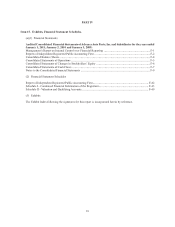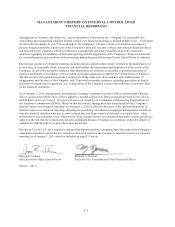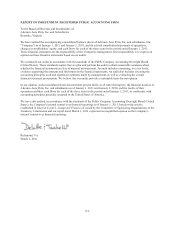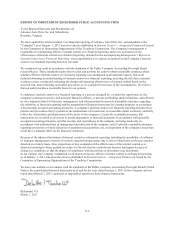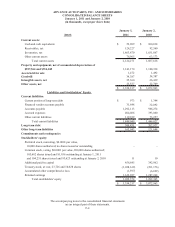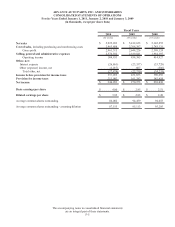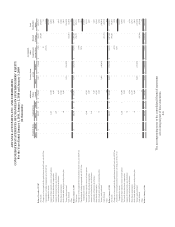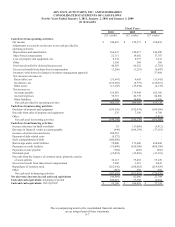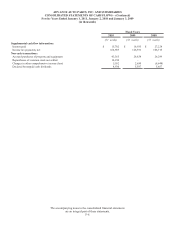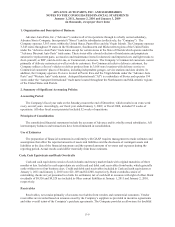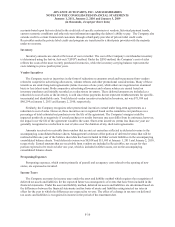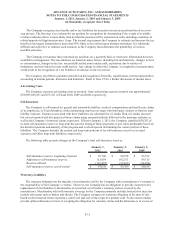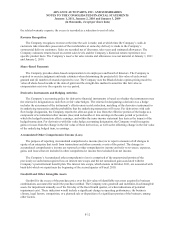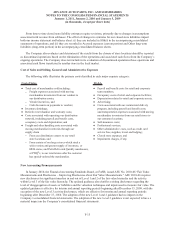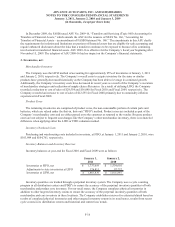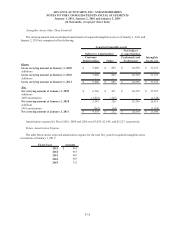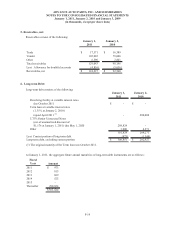Advance Auto Parts 2011 Annual Report Download - page 64
Download and view the complete annual report
Please find page 64 of the 2011 Advance Auto Parts annual report below. You can navigate through the pages in the report by either clicking on the pages listed below, or by using the keyword search tool below to find specific information within the annual report.ADVANCE AUTO PARTS, INC. AND SUBSIDIARIES
NOTES TO THE CONSOLIDATED FINANCIAL STATEMENTS
January 1, 2011, January 2, 2010 and January 3, 2009
(in thousands, except per share data)
.
F-10
accounts based upon factors related to the credit risk of specific customers or vendors, historical payment trends,
current economic conditions and other relevant information regarding the debtor’s ability to pay. The Company also
extends credit to certain Commercial customers through a third-party provider of private label credit cards.
Receivables under the private label credit card program are transferred to a third-party provider with the majority
under no recourse.
Inventory
Inventory amounts are stated at the lower of cost or market. The cost of the Company’s merchandise inventory
is determined using the last-in, first-out ("LIFO") method. Under the LIFO method, the Company’s cost of sales
reflects the costs of the most recently purchased inventories, while the inventory carrying balance represents the
costs relating to prices paid in prior years.
Vendor Incentives
The Company receives incentives in the form of reductions to amounts owed and/or payments from vendors
related to cooperative advertising allowances, volume rebates and other promotional considerations. Many of these
incentives are under long-term agreements (terms in excess of one year), while others are negotiated on an annual
basis or less (short-term). Both cooperative advertising allowances and volume rebates are earned based on
inventory purchases and initially recorded as a reduction to inventory. These deferred amounts are included as a
reduction to cost of sales as the inventory is sold since these payments do not represent reimbursements for specific,
incremental and identifiable costs. Total deferred vendor incentives included in Inventory, net was $71,999 and
$46,294 at January 1, 2011 and January 2, 2010, respectively.
Similarly, the Company recognizes other promotional incentives earned under long-term agreements as a
reduction to cost of sales. However, these incentives are recognized based on the cumulative net purchases as a
percentage of total estimated net purchases over the life of the agreement. The Company's margins could be
impacted positively or negatively if actual purchases or results from any one year differ from its estimates; however,
the impact over the life of the agreement would be the same. Short-term incentives (terms less than one year) are
generally recognized as a reduction to cost of sales over the duration of any short-term agreements.
Amounts received or receivable from vendors that are not yet earned are reflected as deferred revenue in the
accompanying consolidated balance sheets. Management's estimate of the portion of deferred revenue that will be
realized within one year of the balance sheet date has been included in Other current liabilities in the accompanying
consolidated balance sheets. Total deferred revenue was $8,018 and $11,695 at January 1, 2011 and January 2, 2010,
respectively. Earned amounts that are receivable from vendors are included in Receivables, net except for that
portion expected to be received after one year, which is included in Other assets, net on the accompanying
consolidated balance sheets.
Preopening Expenses
Preopening expenses, which consist primarily of payroll and occupancy costs related to the opening of new
stores, are expensed as incurred.
Income Taxes
The Company accounts for income taxes under the asset and liability method which requires the recognition of
deferred tax assets and liabilities for the expected future tax consequences of events that have been included in the
financial statements. Under the asset and liability method, deferred tax assets and liabilities are determined based on
the differences between the financial statements and tax basis of assets and liabilities using enacted tax rates in
effect for the year in which the differences are expected to reverse. The effect of a change in tax rates on deferred
tax assets and liabilities is recognized in income in the period of the enactment date.


